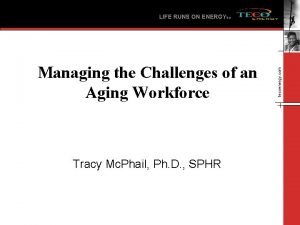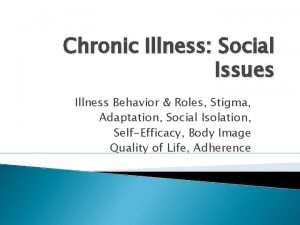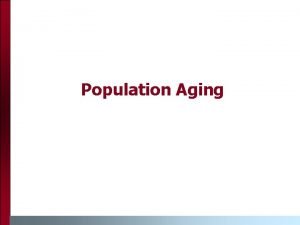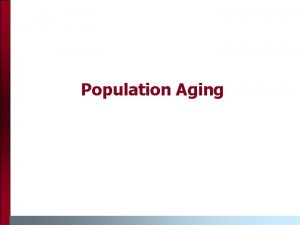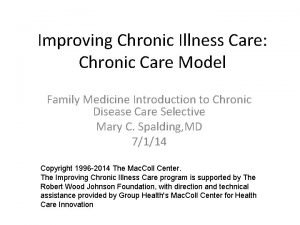Resource Review for Teaching Chronic Illness and Aging













- Slides: 13

Resource Review for Teaching Chronic Illness and Aging Section 6: Policy Issues Related to Aging and Chronic Illness Gunnar Almgren, University of Washington, School of Social Work

Synopsis Three policy issues related to aging and chronic disease are highlighted and briefly explored: 1) Health care inflation and the sustainability of public financing programs for the care of the chronically ill and disabled. 2) The need to transform the dominant paradigm for the organization and financing of health care as pertains to chronic disease. 3) The persistence of health care disparities within the aged and chronically ill population despite universal insurance coverage under Medicare.

Sustainability of public financing programs for the care of the chronically ill and disabled § Growing health care expenditures: Ø In 2006, national health care expenditures increased by 6. 7% to 2. 1 trillion dollars, or 16% of the gross domestic product (GDP). Ø The rate of inflation in health care during 2006 was two times the rate for the economy as a whole. Ø The proportion of GDP represented by health care expenditures has grown from 7. 2% of the GDP in 1970 to its current rate of 16. 0% Ø This is about twice the proportion of the GDP spent by comparable industrialized democracies like France, the United Kingdom, and Canada. Ø Greatest impact of this inflation is seen in high cost of health care insurance for all Americans

Impact of health care inflation on publicly funded programs § Health care inflation has particularly detrimental consequences for the publicly funded programs serving the poor, the disabled, and the elderly. § The principal health insurance fund for the older adults, Medicare Hospital Insurance Trust Fund, is projected to be exhausted by the year 2019. § The Medicaid program, which accounts for nearly one third of publicly funded national health care expenditures, is subject to the same inflationary pressures as Medicare.

Chronic illness and health care expenditures § One factor contributing to health care inflation is that a small proportion of the chronically ill (both elders and non-elders) account for a very large share of health care expenditures. § About 27% of health care expenditures have been concentrated among the sickest 1% of the population—of which about half are elders. § A large share of national health care expenditures (49%) are also concentrated among five chronic conditions—three of which (diabetes, hypertension, and heart disease) are closely linked to the process of aging. § Two essential policy alternatives are: § reductions in expenditures through cost cutting § major shift in the national patient care paradigm.

Transforming the dominant paradigm in the organization and financing of health care The Acute Care Paradigm § The U. S. health care system evolved primarily during the first half of the 1900 s, an era in which infectious diseases and critical short-term illnesses were dominant among causes of death, rather than chronic diseases. § The “acute care paradigm” placed emphasis on patient care systems that were effective for the treatment of periodic episodes of care over the life course. § Health insurance models were designed to insure patients against the catastrophic costs of episodes of hospital care. § Implicit in the acute care paradigm was the inflationary assumption that more intensive medical intervention during any given episode was generally better.

The Emergence of Chronic Disease § Chronic diseases have become the dominant causes of death and disablement and the primary reason why people seek medical care. § By the year 2020 nearly 160 million Americans will have one or more chronic condition that in turn will account for 80% of all health care expenditures. § In order for the U. S. health care to turn from collapse toward the path of fiscal sustainability, its primary patient care paradigm must rapidly evolve to a model of chronic disease management.

Implementing a Chronic Care System: Key Policy Challenges Included among these policy challenges are: § The development of clinical information systems better capable of supporting coordination of care. § Improvement of ambulatory care management of chronic conditions that contribute to unnecessary hospitalizations. § Aligning physician and other provider payment mechanisms and incentives with disease management over time rather than episodic treatment of acute symptoms. § A shift from specifically disease focused interventions to interventions that are tied to functional impairments. § Integrating informal and formal support systems with medical case management.

Restructuring health care benefits to address a chronic disease management model § Under the current structure of the Medicare, all forms of provider care must fit within a very narrow definition of medical services to be reimbursed, a definition of care that excludes the kinds of chronic disease management services needed. § Medicaid has become the primary means of funding the kinds of long-term care services that are essential to the holistic management of chronic disease.

Impact of structural fragmentation of health care services § The U. S. lags far behind other affluent democracies in reducing premature deaths from diseases that are amenable to timely and effective medical care—despite the fact that the U. S. far exceeds all other affluent democracies in health care system expenditures. § The structural reforms in Medicare and in the organization of health care services that are required face formidable political obstacles from various provider groups that have strong economic interests in protecting the status quo.

Addressing disparities in the care of the chronically ill older adults: the role of race, class, gender, and social stigma § The Medicare program provides universal health coverage for older Americans. § Having Medicare health insurance does not assure either equity of access to health care or equity in health care quality. § Medicare health insurance coverage reduces the disparities in access and quality of health care that are prevalent across all earlier stages of the life course, but disparities in health care by race, ethnicity, social class, and gender persist throughout the oldest age ranges as well. § One mechanism of disparities that affects older adults is the social stigma (devalued status) that is attached to the combined attributes of advanced age and advanced chronic disease— resulting in discriminatory health care.

Double jeopardy: Impact of aging, social class, race, ethnicity, gender Ageism § Older adults (particularly those with disabling chronic conditions) confront a kind of double jeopardy in their quest for appropriate and equitable care. § Ageism in the health care system is manifested by such clinical decisions as deferring lifesaving intervention despite otherwise favorable clinical indicators and social policy perspectives that argue for age-based limits on health care.

Social class, race, ethnicity, and gender § The 2005 National Healthcare Disparities Report, examined disparities in health care among the elderly by three dimensions: prevention, timeliness of care, and access to care. § The findings of this report showed significant disparities in health care by race, ethnicity, and socioeconomic status across all three dimensions considered. § The 2005 National Healthcare Disparities Report finds that Hispanic, African American, or low income elders are far less likely to have a usual source of medical care and when seeking care have longer wait times for their medical appointments. § Medicare’s universal health care coverage is insufficient by itself to overcome the deeply embedded disparities in the U. S. Health Care system. § The eradication of health care disparities throughout the life course must be elevated as a central principle of health care reform.
 Improving chronic illness care model
Improving chronic illness care model Kentucky aging and disability resource center
Kentucky aging and disability resource center Dane county aging and disability resource center
Dane county aging and disability resource center Resource loading vs resource leveling
Resource loading vs resource leveling Perbedaan resource loading dan resource leveling
Perbedaan resource loading dan resource leveling Differences between micro teaching and traditional teaching
Differences between micro teaching and traditional teaching Market forms poultry
Market forms poultry Jessie emily schofield poem
Jessie emily schofield poem Trends in cognitive sciences
Trends in cognitive sciences Managing the aging workforce challenges and solutions
Managing the aging workforce challenges and solutions Office of aging
Office of aging Office of aging and adults services
Office of aging and adults services Mental health and mental illness chapter 20
Mental health and mental illness chapter 20 Name 5 sudden illness.
Name 5 sudden illness.









